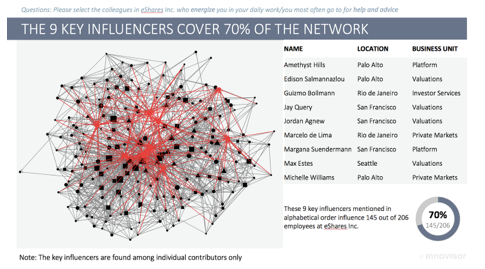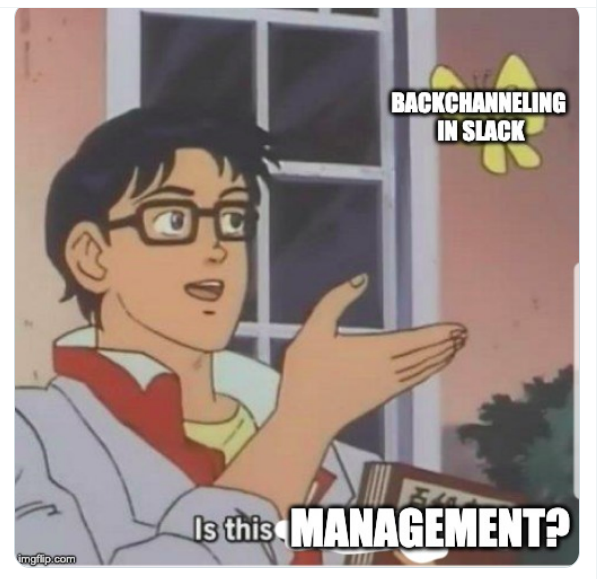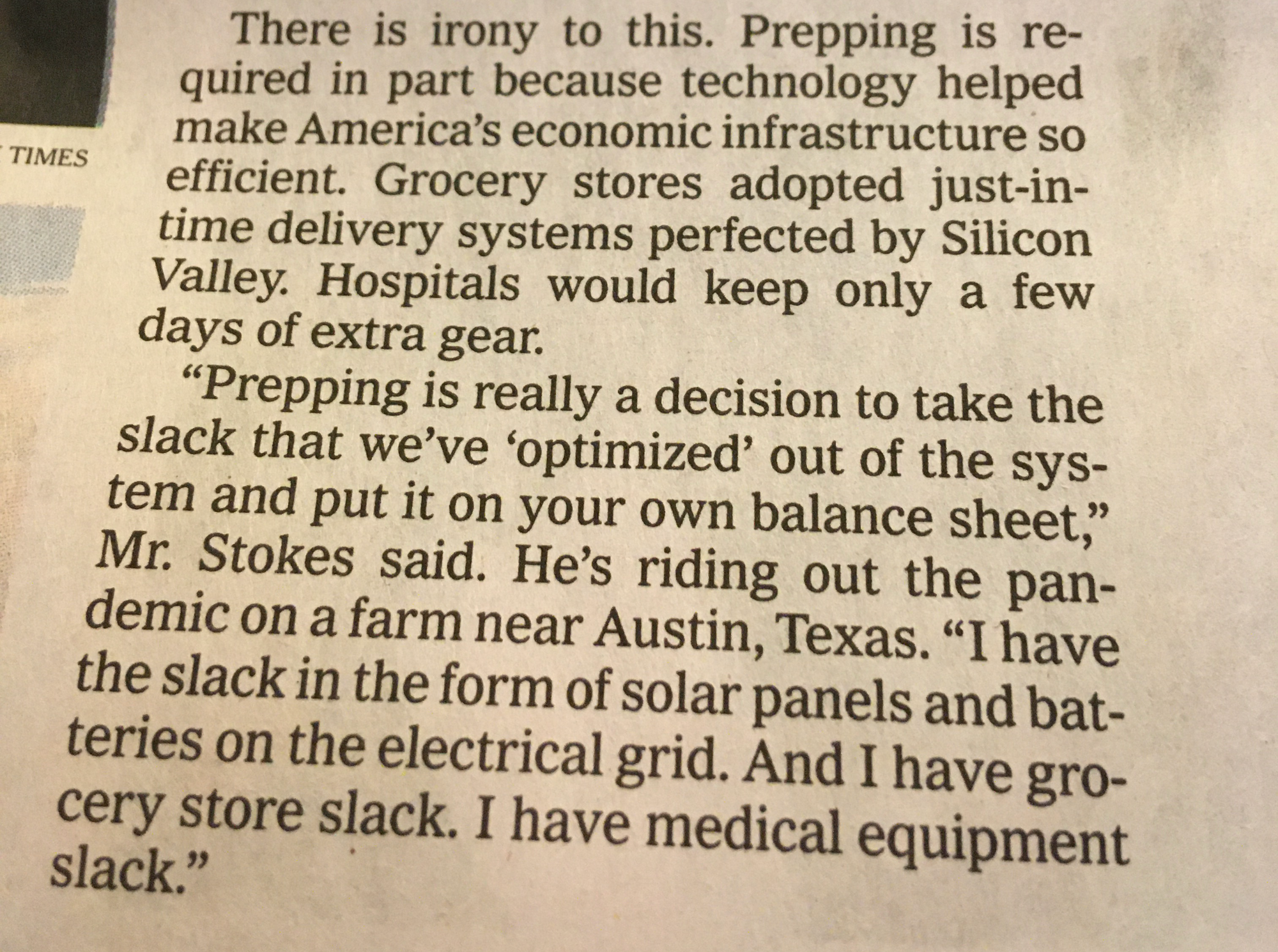Information supply chain, interrupted: Members Only #15

June 2022 Update: I removed the paywall on this May, 2020, and edited a number of articles, mostly to improve formatting, fix broken links, and remove info about live events that happened back then.
Whether you’re a longtime reader or new joiner, I’m heartened that you’re here.
If you’re concerned about finances, and wish to suspend your subscription payments, switch from monthly to lump sum, or something else, please let me know.
Many thanks for supporting my newsletter, financially and via word of mouth.
You have an information supply chain
Mental heath is high on the list of concerns I’m hearing from folks in my circle.
Your organization may have an Employee Assistance Program, or offer access to therapy through health insurance.
However, I’ve heard that people aren’t always making use of these services.
I recently advised someone to enlist communications staff — maybe your team members don’t understand how your EAP services work.
On reflection, you might also consider how information flows in your organization. Maybe people aren’t so receptive to emails from HR right now.
A rare standout in the Startup CEO Blog Post* genre, Henry Ward’s The shadow org chart describes how his team uncovered networks of trust and influence criss-crossing his organization.

Ward said, “This group influences 70% of our 250 employees…if we wanted to spread a meme, this is the ten we would start with.” Notably, their influencers were not team leaders.
In your organization, information once flowed based on seating arrangements, friend groups, random interactions. And, through people who are trusted.
Information moved on a supply chain, fuelling relationships, decisions, and power.
Your information supply chain might be broken right now.

very proud of this meme i made today pic.twitter.com/EEzELaGhC2
— dr. kpan (@panacirema) June 13, 2019
Like I said, your information supply chain might be broken right now.
Now is probably not the time for this kind of analysis. You can think about your trusted super-communicators, though.
You probably know who they are.
If there’s important information that your employees aren’t acting on, these folks might be able to help you to figure out how to get the word out.
(And if you’ve had to lay people off, that’s another reason to think about your informal information flows — and how you might get communication moving again.)
* October 2020 comment: I always think long and hard before sharing a startup CEO’s blog post, because I’ve learned there’s always a chance that news will come out one day, and cast a shadow on their credibility. Oof.
Watching the future > predicting the future
In no particular order, there are some themes I’m watching, from a perspective largely informed by the culture and practices of knowledge work.
Social distancing. Once people can safely get back to the office, many of our open plan offices aren’t conducive to 6 feet of personal space; organizations will need to make a plan. (Maybe something will happen with all of that WeWork space?)
Some of the people wearing masks on their chins at the grocery store might be your co-workers: who’s going to be the mask police in your office?
Sustainable remote work. People who were once told that they can’t work remotely may now be doing so. They may have moved to another state, or country. The ship has sailed on the Old Normal.
The toddler face-down-on-the-floor tantrum may be indulged in the Present Now. Not so much a year from now.
We’ll have to be better managers to find good ways to support and evaluate success.
Privacy. Surveillance is being sold as a productivity tool. Um, that sounds awful.
And so does having people somehow “certify” their health status. Especially as there’s a lot that’s unknown about how COVID-19 operates, and whether you — a non-medically trained business person — can accurately assess someone’s health status.
MBA programs. They were already in trouble; the rent was too damn high. Anti-immigration sentiments and policies have dampened the interest of non-US students, who typically have paid full freight.
Tough times have typically led people back to school. Will young people go into (more) debt for online MBAs?
Worker rights and benefits. How will the job be (further) deconstructed? What will unions do?
Predicting the future is BS
In the Before Times, I started traveling a lot. I tried carrying my laptop in a cute tote. It didn’t work.
What I needed, apparently, was basically an office on straps. Something padded, with so many compartments that stuff gets lost. Something that looks like a Toy Story character, about to stand up on two legs and bellow: “BRO!”
When I set up my WFH office nook, I emptied my backpack. In one seldom-used compartment, a time capsule: a perfectly preserved issue of Travel and Leisure.

Also, a small zipper pouch containing pens and receipts, and drawing I hadn’t forgotton. Something I had been ruminating on for a couple of years. I carried it all the time, on purpose, and it’s now on my bulletin board.
When I started thinking about On Management as a small but mighty line on my P&L, I took a look at what Ben Thompson had done with Stratechery. He had a model, a focus.
He drew his model, and wrote about it, refined it, and drew it again.
“Should I have a model,” I wondered. I mean, I had a model, in my mind.
I didn’t have a drawing. So, art student style, I drew a model in the style of Stratechery guy. (Anne’s Unified Theory of Work, per Gary Chou.)
I was — and am — interested in what work provides to employees.
Structure, community, a stream of cash flows, training, benefits, more:
- How they’ve changed over time
- How they’re changing now
- How they might continue to change
- What I’m doing to create or influence change.
My management development programs and coaching work have existed in the cracks between the way things used to be, the way things are, and what they’re becoming.
In this liminal moment, we’re even less sure of what’s happening than we thought we were. People who say that they know what the future will bring are not likely to be correct.
Part of why I write is to figure out where I’m going.
Instead of my Ben-Thompson-style casting of the job, what if I were to look at work like a job is a SaaS product: Job as a Service?

Each tier provides a set of benefits. For argument’s sake:
- 1099 includes who aren’t considered employees, like (some) farm workers, Uber drivers, and freelancers like me.
- Tier I is where I’d put warehouse and retail workers, also health care aides, and food service workers. Folks in the US who are considered employees.
- Tier II might be entry level knowledge workers, teachers, skilled/degreed medical workers, first responders, front-line managers in larger companies.
- Tier III would include management ranks of larger companies, business owners.
Hmmm.
For the benefits, let’s go to the Excel spreadsheet.

- Red: Nope, not included
- Purple: It’s Complicated
- Green: Yes
One of my main observations: the Tier III product features were once afforded to more people in Tiers I and II. And, 1099 is a convenient name for an inconvenient, murky category.
Higher education is a case in point. Once upon a time, professors were in the same tier. Today, some (tenured) professors are Tier III. Adjunct professors, not so much.
My big question about our present moment is, what colors will predominate my 2025 version of this chart?
And how will I participate in the events and processes that get us there? Because the future of work is something we’re co-creating. Today. In this moment.
I have more to say on all of this. For example, I might want to elaborate on “It’s complicated,” and “Platform.” One thing about “It’s complicated” — the benefits of employment are not equally distributed.
Also, there must be better categorizations for these “tiers” than mine! Maybe via government/Bureau of Labor Statistics, academia or elsewhere.
If you can school me on this, please do! And I’ll keep poking around.
Also, I updated the grid-slash-model in 2021 to include Performance of Care.
AMAs and transcripts
Practicing what I preach, I periodically consider what I should do more, do less, do differently, and stop doing.
I’m going to do my AMA/Office Hours differently. You may book a time in May or June here.
I have loved our conversations, and don’t need to hang onto the administrative overhead of setting aside special days for them. So, stay tuned on the future of AMAs.
Also, I didn’t create a transcript for my most recent audio conversation, with Ana Milicevic about meetings. Please let me know if you missed it. If nobody did, I will likely stop creating transcripts.
A link

- “The billionaire class are saying, ‘Yeah, you know, hey guys, we can’t keep doing this. They’re going to come for our food.’” I Used to Make Fun of Silicon Valley Preppers. Then I Became One by Nellie Bowles at The New York Times. I’ve read this three times now.
Whose Thought Leadership should go into designing the future of work?
Because I don’t want it dominated by people who think that I might be coming for their food.
Management 201
After I announced a possible cohort for my Management Intensive program, I heard from experienced managers, people who need something different than the basics I offer in the Intensive.
If we haven’t already talked, send me a note if you — or someone on your team — is interested in a Management 201 program I’ll be piloting. It’s for folks with 4+ years managing people, and the pilot cohort will be small.
Many, many, thanks for your support of On Management. Please do share it with a friend or co-worker.
The version you receive today will inevitably contain a typo, much to my dismay, which I’ll find when I re-read it down the road, and will fix on the web version.
If there’s a topic you want to hear more from me about, send me a note!
Thank you, and may you and yours be safe, healthy, and in peaceful conditions.





